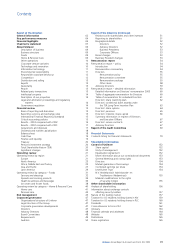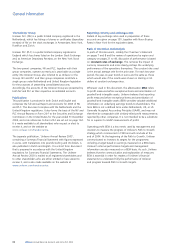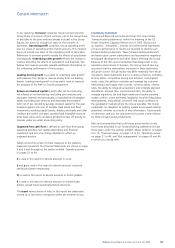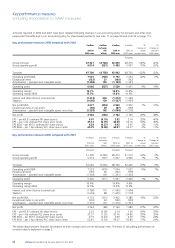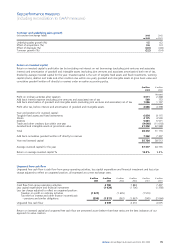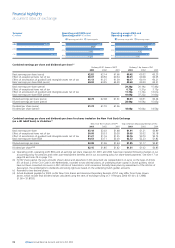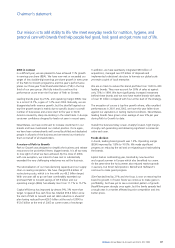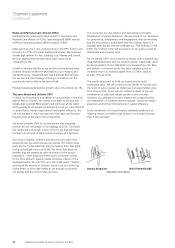Unilever 2003 Annual Report Download - page 14
Download and view the complete annual report
Please find page 14 of the 2003 Unilever annual report below. You can navigate through the pages in the report by either clicking on the pages listed below, or by using the keyword search tool below to find specific information within the annual report.Unilever Annual Report & Accounts and Form 20-F 2003 11
About Unilever
In total, Unilever filed 397 new patent applications. While some
innovations made a significant contribution in 2003, the benefits
of others will be felt during 2004.
Information technology
In 2003 we continued to direct our IT towards achieving
Unilever’s strategic objectives.
We further simplified business processes and core transaction
systems, using IT to enable a simpler and more agile business.
In Western Europe, almost all our Home & Personal Care business
is now operating with common processes, supported by common
information and SAP systems, as are the Foods businesses in the
larger European markets. Similarly, much of our business in sub-
Saharan Africa has moved to common processes and systems for
supply chain and finance. In North America, we deployed a single
system from point of order to cash settlement across the Home
& Personal Care business, improving operational efficiency and
raising customer service levels.
Our Latin American business continued to roll out common
finance and supply chain processes, information and systems
across the region, and started an IT-enabled programme to
simplify human resources processes. A single system (Siebel)
has been introduced for customer relationship management,
enabling the roll-out of good practices in field sales, key account
management and trade marketing operations. We have also
deployed Siebel in our Foodsolutions businesses in Europe and
North America, with further roll-out under way in consumer foods
in Europe.
In Asia, we began implementing Siebel decision support systems
for trade marketing investments, with completion across the
region scheduled for 2004. We have also rolled out the standard
Unilever data warehouse in six countries so far, with at least four
more Asian markets to follow in 2004. This system, firmly based
on information standards, provides our sales operations with
better quality and more timely information than ever before.
Following the signing of our global contract with British
Telecom (BT), we are targeting a 20% reduction in our
telecommunications costs, by reducing the number of our
suppliers around the world from 400 to one. For Unilever IT this
is the first implementation of such a contract on a global scale
and has resulted in a high level of learning for both organisations.
This complex project is on track, with BT now providing voice,
mobile and data services for more than half of our business.
During 2003 work started on the simplification of our IT server
base. This will involve a significant reduction in the number of
servers as well as increased performance and utilisation. This work
is fundamental to the IT strategy and will continue over the next
two years.
Our global e-business gateway, the Unilever Private Exchange,
strengthens our e-business capability by providing secure links
between our operating companies and our suppliers’ and
customers’ systems and to external electronic marketplaces.
By year-end, the volume of customers’ orders being transacted
through the gateway had reached the annual equivalent of
€2 billion.
Our Ariba online buying system enables purchases of non-
production items to be made at volume-negotiated prices from
selected suppliers. We have extended its use into further areas
of procurement including market research and plant items. Using
eBreviate technology, we have introduced new capabilities for
electronic auctions and electronic requests for proposals.
The success of these marketplaces and gateways is, of course,
dependent on industry standards for electronic information
exchange. We continued our commitment to industry standards
by co-chairing the Global Commerce Initiative, a global user
group representing the largest companies in our industry,
and participating fully in the development and promotion
of standards. Using these standards, we are now making our
electronic catalogue of products available through the Unilever
Private Exchange, further simplifying ordering for retailers and
gaining efficiencies in our information supply chain.
Unilever continues to take an active role in the application of IT in
our industry. We are working actively with retailers to realise the
potential of Radio Frequency Identification (RFID) technology, or
‘intelligent tagging’, to achieve new levels of shared information
on our products as they move from factory to supermarket shelf.
Environmental responsibility
We continue to make progress towards our long-term eco-
efficiency objectives, as well as driving forward our three main
initiatives on sustainable agriculture, fish and water. All these
activities are central to our commitment to contribute to
sustainable development.
Our manufacturing operations use seven parameters for reporting
emissions and setting future reduction targets for eco-efficiency.
We have continued to improve our eco-efficiency performance
although we did not meet three out of seven of our targets in
2002 (latest data). The setting and achievement of targets at
site level can be difficult, for example, ongoing changes in our
business through acquisitions, disposals and closures have an
impact on our site operations.
If we are to secure a continuing high-quality supply of our main
agricultural raw materials, sustainable production methods are
crucial. In 2003, five years after laying the foundations for the
current programme, we published Good Agricultural Practice
Guidelines for five crops – palm oil, peas, spinach, tea and
tomatoes. We also began implementing these guidelines
across a broader supply base. Learning and sharing with all
stakeholders is vital, and some success stories are available on
www.growingforthefuture.com. The next challenge is to develop
programmes for more crops, beginning with vegetable oils. This
work is being supported by the food industry’s jointly established
Sustainable Agriculture Initiative Platform.
The Marine Stewardship Council (MSC) has established a global
standard for sustainable fisheries. We encourage our suppliers to
work towards the MSC Standard, and three important fisheries
are making good progress towards this certification – Alaskan
pollock, Chilean hake and South African hake.
At the start of 2003, we were buying more than a third of our
fish from sustainable sources, and by 2005, we expect this figure


